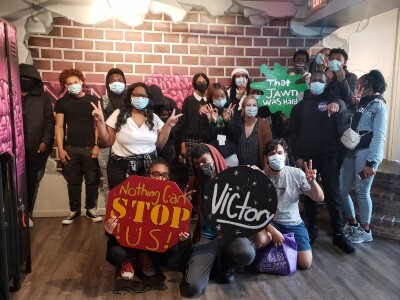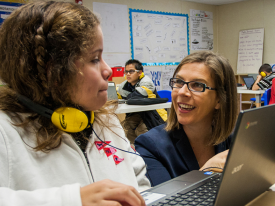Taking Action toward DEI and Antiracist Commitments Remotely
Topics

Together, educators are doing the reimagining and reinvention work necessary to make true educational equity possible. Student-centered learning advances equity when it values social and emotional growth alongside academic achievement, takes a cultural lens on strengths and competencies, and equips students with the power and skills to address injustice in their schools and communities.
Considerations to advance DEI and antiracist work at a distance.
Racism has plagued our country since its inception. Ahmaud Arbery, Breonna Taylor, George Floyd, Tony McDade, Dion Johnson, and far too many other Black people have been murdered due to racial violence and police brutality—symptoms of the broader White Supremacy Culture that pervades through every thread of our country’s fabric. Though it’s been a long time coming, our society is collectively holding up a mirror, confronting our systemic inequities, and taking a stand: Black Lives Matter.
While protests and demonstrations demand critical change, the shuttering of workplaces strips us of opportunities to connect and engage in person with work colleagues to address racial violence. Even though options for connecting are limited right now, we can create spaces in remote settings to provide support, interact, and dedicate time and resources to ongoing action, backing up commitments to equity and racial justice.
We have to. When we live in highly segregated neighborhoods, when politics polarize, when the pandemic keeps us isolated, and when racism persists, the distance in our workplaces must not serve as another dehumanizing force. This work is not a nice-to-have—it’s our responsibility.
What does it look like to demonstrate care remotely? How do we advance essential diversity, equity, and inclusion (DEI) and antiracist work at a distance?
The seven organizations of the Remote DEI Collective (RDC) have been remote or partially remote for longer than the pandemic, and we have been committed to engaging in matters of DEI and antiracism remotely. While we do not claim to have all the answers, we offer some considerations as we all navigate these unprecedented times. Whether you’re a leader who is able to set team priorities or a team member advocating for team needs, consider these ideas:
Center Black Voices and Perspectives
As authors of this article, we are not Black: we identify as White and Asian American. We know that we cannot speak on behalf of any perspective but our own, and to start with our ideas would be to center the conversation on ourselves.
Acting in this way would reinforce racist actions, as described by Equity Meets Design in its Organization-Wide Equity Pause toolkit:
“Ultimately, these activities signal deep invalidation: by creating more visibility for white folks’ emotions and processing, and by centering them, Black folks’ experiences, needs, and emotions are rendered even more invisible. By crafting a white-dominant narrative of what this moment is, who and what it is for, and continuing the horrific legacy which expects unpaid labor from Black folks (in this case, that might look like engaging, educating, consoling, tip-toeing), this response amounts to gaslighting of the highest order.”
Organizations that commit to DEI and carry out the work of antiracism must prioritize the voices, perspectives, needs, and demands of Black communities and follow their lead. And within organizations, leaders need to center the work on the voices, perspectives, needs, and demands of Black employees while also ensuring they are not overburdened with the responsibility of educating colleagues. Here are resources from Black leaders with guidance around what employees need and what organizations, school systems, and businesses can do:
- Alica Forneret, Culture Amp: One Black employee’s answer to “How can I help?”
- Shenequa Golding: Maintaining Professionalism In The Age of Black Death Is….A Lot
- Vanessa Douyon: 50 Actions Your Org Can Take After Posting About BLM
- Tonya Russel: Check in on Your Black Employees, Now
- Caroline Hill: We know how this ends. It’s time to share the pen and rewrite the story.

(Photo by Andrea Piacquadio)
Consider the Challenges of Remote Culture in Your DEI Actions
As a nation, we are not very good at or experienced in addressing racism—and certainly not virtually. How might we follow the guidance of Black employees and Black leaders to demonstrate care and advance DEI and antiracist work at a distance?
First, consider the dynamics of remote work culture, examining challenges with a DEI lens. Over video calls and teleconferences, it’s easy to only present a “professional” persona, masking personal feelings or emotions. Without physical proximity and the ability to read body language, non-verbal cues can be lost. Interactions are often limited to scheduled conversations, making it easier to “turn on” for such calls and avoid vulnerable conversations altogether. Without the right conditions, trust is not fostered, and individuals—particularly Black, Indigenous, and People of Color (BIPOC)—are unable to participate authentically. Elements of remote culture like isolation, the pressure to produce, and over-reliance on written communication exacerbate White Supremacy Culture and, left unchecked, trigger more harm and pain for BIPOC.
The Remote DEI Toolkit—a website where the RDC has published its emerging insights on navigating DEI remotely—provides tools for organizations to undertake DEI efforts remotely, like building trust, implementing intentional cultural practices, setting DEI metrics, and more. We offer the following considerations based on the RDC’s emerging insights:
- Rather than jumping too quickly to action, take a decision pause. Acting with urgency can feel responsive, but doing so often means that those without power—and proximity, particularly across remote teams—are not considered in these decisions. Pause to listen, empathize, and center on Black experiences.
- Foster the necessary conditions for brave spaces in virtual meetings. First, a disclaimer: do not require Black colleagues to participate or share. Doing so may retrigger and overburden Black folx. But in virtual calls and meetings, especially DEI conversations, avoid falling into the mask of professionalism and implement strategies to enable courageous conversations.
- Commit to ongoing conversations and learning through virtual reading groups. Don’t let your commitments end with an email; create ongoing virtual spaces to allow colleagues to learn, reflect, and act. Intentionally design conversations to optimize participation given remote dynamics.
- Implement changes. Based on where your organization is in its journey toward antiracism, identify your first next step, and take action. The toolkit offers recommendations for remotely implementing strategies like establishing a DEI Change Team, centering DEI goals in recruitment, hiring, and onboarding, and exploring and enacting changes to mitigate White Supremacy Culture.
As we mentioned earlier, we don’t have all the answers, and we continue to seek Black voices and perspectives to follow as our organizations continue our own DEI commitments and antiracist work. What considerations would you add? What tools and resources have you found valuable? Who do you recommend we listen to and learn from?
Other resources we’ve found helpful:
- The Management Center: So you’ve declared that Black Lives Matter. Now what?
- Diversity Equity Inclusiveness Consulting: Leading during traumatic and triggering events
- ProInspire: Crises as a Catalyst: A Call for Race Equity & Inclusive Leadership
- NOBL: Resources for Building Anti-Racist Organizations




